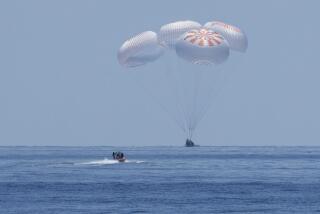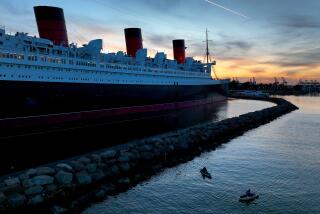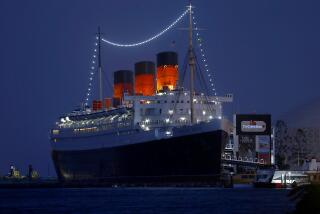Former Soviet Spy Sub Joins Forces With Queen Mary
- Share via
Just in case there were any lingering doubts, Long Beach tourism boosters have served notice that the Cold War is officially over.
How else to explain the sudden (but peaceful) appearance of a Soviet Union Foxtrot-class submarine in the city’s harbor last week? Dubbed “the Scorpion” by its Russian builders, the submarine was pulled by tugboats to its new home alongside the Queen Mary on Saturday, while preparations to convert the onetime nuclear threat into this city’s latest waterfront tourist attraction began. Commissioned by the Soviet Navy in 1972 when the Cold War was still plenty warm, the 2,000-ton, 300-foot-long Scorpion was once equipped with low-yield nuclear torpedoes. It patrolled Pacific waters and was assigned primarily to gather intelligence on the naval activities of not-so-Soviet-friendly nations, like the U.S. But now, after stops in the Bulgarian Navy and as an Australian tourist site, the idled Scorpion is riding shotgun to Long Beach’s luxury ocean liner.
“It might seem like an odd juxtaposition,” said Joseph Prevratil, president of the RMS Foundation, the nonprofit group that runs the Queen Mary and brought the Scorpion to the Southland. “But I think that just makes it more effective.”
Long Beach has tried for years, with mixed success, to lure visitors to the luxury liner.
“The Queen Mary, while an awesome attraction by itself, is not one that you would return to after having been there,” said Long Beach Assistant City Manager Henry Taboada. “It’s not an attraction that changes enough to come back to.”
Recognizing this, various organizations have tried to spice up the “Queen Mary experience” with everything from bungee jumping to Titanic exhibits. One particularly ill-fated attempt, made when the Disney Co. ran the site, was turning the legendary Spruce Goose airplane into a costly tourist attraction. Disney lost millions and eventually bailed out altogether. The plane was moved to Oregon in 1993.
Although Prevratil said he doesn’t think the Spruce Goose venture was a failure, he is quick to say the Scorpion is different. For one, the submarine exhibit is temporary. In five years, it will return to its Australian owners. The investment too, although “more than a couple million” dollars, is substantially less than it took to house and maintain the wooden plane.
And combined with other developments along the waterfront, like the new Aquarium of the Pacific, Long Beach boosters are confident of success. “This is just another in a series of opportunities to sell Long Beach, to bring people back,” Taboada said. “It’s one more arrow in our quiver.”
Tours of the Scorpion will include a descent into the engine room and the communications center and walks along its long, narrow hallways. The RMS Foundation plans a movie on submarine history, and there will, of course, be a gift shop.
But before the Scorpion opens to the public in mid-July, Long Beach plans to polish the communist-era boat a bit.
“We want to bring it up to American quality standards,” Prevratil said.
The sub was in active service for 22 years, and it looks every bit its age. Looking at the vessel’s rusted, worn exterior, one woman said: “It looks like a dead cigar.”
Judging from reactions Saturday though, interest in the sub should be high, regardless of its rough edges. As the black snout of the Scorpion eased out of the special semi-submersible ship that carried it across the Pacific, pleasure boaters and power skiers zoomed around, gazing at the monstrous sub.
But the irony of a communist warship serving as a $10 tourist stop for American capitalists was too much for UCLA graduate student Lindsey Atherten.
“What,” she said, “would Lenin think?”
More to Read
Sign up for The Wild
We’ll help you find the best places to hike, bike and run, as well as the perfect silent spots for meditation and yoga.
You may occasionally receive promotional content from the Los Angeles Times.






